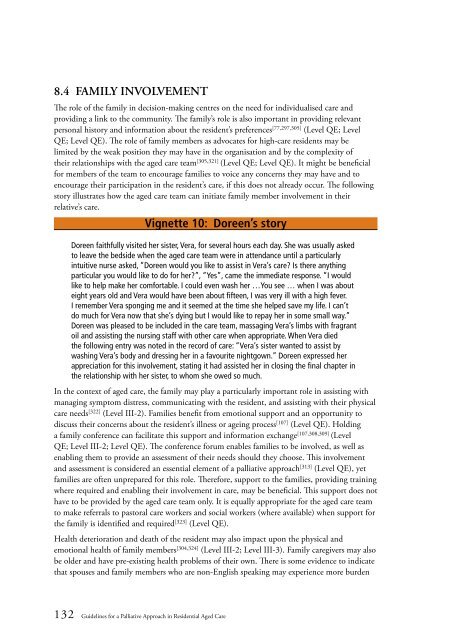Guidelines for a Palliative Approach in Residential Aged Care
Guidelines for a Palliative Approach in Residential Aged Care
Guidelines for a Palliative Approach in Residential Aged Care
You also want an ePaper? Increase the reach of your titles
YUMPU automatically turns print PDFs into web optimized ePapers that Google loves.
8.4 FAMILY INVOLVEMENT<br />
The role of the family <strong>in</strong> decision-mak<strong>in</strong>g centres on the need <strong>for</strong> <strong>in</strong>dividualised care and<br />
provid<strong>in</strong>g a l<strong>in</strong>k to the community. The family’s role is also important <strong>in</strong> provid<strong>in</strong>g relevant<br />
personal history and <strong>in</strong><strong>for</strong>mation about the resident’s preferences [77,297,305] (Level QE; Level<br />
QE; Level QE). The role of family members as advocates <strong>for</strong> high-care residents may be<br />
limited by the weak position they may have <strong>in</strong> the organisation and by the complexity of<br />
their relationships with the aged care team [305,321] (Level QE; Level QE). It might be beneficial<br />
<strong>for</strong> members of the team to encourage families to voice any concerns they may have and to<br />
encourage their participation <strong>in</strong> the resident’s care, if this does not already occur. The follow<strong>in</strong>g<br />
story illustrates how the aged care team can <strong>in</strong>itiate family member <strong>in</strong>volvement <strong>in</strong> their<br />
relative’s care.<br />
Vignette 10: Doreen’s story<br />
Doreen faithfully visited her sister, Vera, <strong>for</strong> several hours each day. She was usually asked<br />
to leave the bedside when the aged care team were <strong>in</strong> attendance until a particularly<br />
<strong>in</strong>tuitive nurse asked, “Doreen would you like to assist <strong>in</strong> Vera’s care? Is there anyth<strong>in</strong>g<br />
particular you would like to do <strong>for</strong> her?”, “Yes”, came the immediate response. “I would<br />
like to help make her com<strong>for</strong>table. I could even wash her …You see … when I was about<br />
eight years old and Vera would have been about fifteen, I was very ill with a high fever.<br />
I remember Vera spong<strong>in</strong>g me and it seemed at the time she helped save my life. I can’t<br />
do much <strong>for</strong> Vera now that she’s dy<strong>in</strong>g but I would like to repay her <strong>in</strong> some small way.”<br />
Doreen was pleased to be <strong>in</strong>cluded <strong>in</strong> the care team, massag<strong>in</strong>g Vera’s limbs with fragrant<br />
oil and assist<strong>in</strong>g the nurs<strong>in</strong>g staff with other care when appropriate. When Vera died<br />
the follow<strong>in</strong>g entry was noted <strong>in</strong> the record of care: “Vera’s sister wanted to assist by<br />
wash<strong>in</strong>g Vera’s body and dress<strong>in</strong>g her <strong>in</strong> a favourite nightgown.” Doreen expressed her<br />
appreciation <strong>for</strong> this <strong>in</strong>volvement, stat<strong>in</strong>g it had assisted her <strong>in</strong> clos<strong>in</strong>g the f<strong>in</strong>al chapter <strong>in</strong><br />
the relationship with her sister, to whom she owed so much.<br />
In the context of aged care, the family may play a particularly important role <strong>in</strong> assist<strong>in</strong>g with<br />
manag<strong>in</strong>g symptom distress, communicat<strong>in</strong>g with the resident, and assist<strong>in</strong>g with their physical<br />
care needs [322] (Level III-2). Families benefit from emotional support and an opportunity to<br />
discuss their concerns about the resident’s illness or age<strong>in</strong>g process [107] (Level QE). Hold<strong>in</strong>g<br />
a family conference can facilitate this support and <strong>in</strong><strong>for</strong>mation exchange [107,308,309] (Level<br />
QE; Level III-2; Level QE). The conference <strong>for</strong>um enables families to be <strong>in</strong>volved, as well as<br />
enabl<strong>in</strong>g them to provide an assessment of their needs should they choose. This <strong>in</strong>volvement<br />
and assessment is considered an essential element of a palliative approach [313] (Level QE), yet<br />
families are often unprepared <strong>for</strong> this role. There<strong>for</strong>e, support to the families, provid<strong>in</strong>g tra<strong>in</strong><strong>in</strong>g<br />
where required and enabl<strong>in</strong>g their <strong>in</strong>volvement <strong>in</strong> care, may be beneficial. This support does not<br />
have to be provided by the aged care team only. It is equally appropriate <strong>for</strong> the aged care team<br />
to make referrals to pastoral care workers and social workers (where available) when support <strong>for</strong><br />
the family is identified and required [323] (Level QE).<br />
Health deterioration and death of the resident may also impact upon the physical and<br />
emotional health of family members [304,324] (Level III-2; Level III-3). Family caregivers may also<br />
be older and have pre-exist<strong>in</strong>g health problems of their own. There is some evidence to <strong>in</strong>dicate<br />
that spouses and family members who are non-English speak<strong>in</strong>g may experience more burden<br />
132 <strong>Guidel<strong>in</strong>es</strong> <strong>for</strong> a <strong>Palliative</strong> <strong>Approach</strong> <strong>in</strong> <strong>Residential</strong> <strong>Aged</strong> <strong>Care</strong>
















